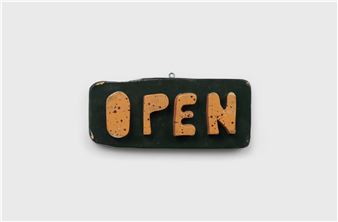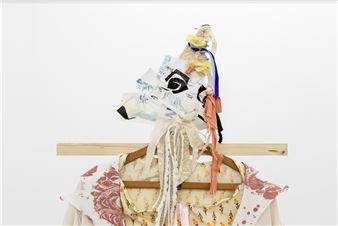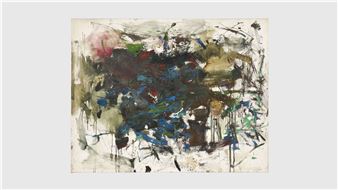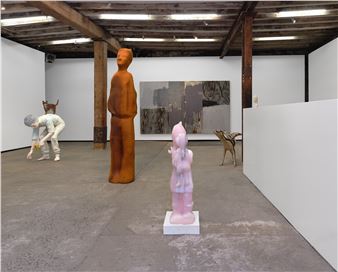Liz Markus: Forever Changes
Their contours come in and out of focus in washes of blue, purple, yellow and red that dance across the canvas. Adorned with aviators and often ill-defined, a long-haired figure emerges. They seem to be here in peace but still clearly emanate a sense of righteous rebellion, staring back at and beyond the viewer.
These dudes in Wayfarers are marked in turn by Liz Markus, who is reaching for something– Waves of energy, galaxies of stars, lush rainforests, vibrations of form and two-color pulsing auras inspire her vision. While Markus calls these subjects “hippies”, she almost obliterates their original countenance to create completely new emblems of freedom, living your own way and generally not giving a fuck, a critical motto for Liz when she needs to let go in the studio.
Painting is like a high-wire act for Markus, who often dares herself to ruin a painting in hopes of enlivening it. Raw stretched canvased are laid out horizontally across her studio floor and then drenched in contrasting liquid acrylic hues. As she builds up the surfaces with layers of very wet pigments, she can only control the bleeds and drips so much, and the resulting images vary greatly despite having the same starting point. Some appear as rainbow-tinted outlines of a carefree hippie staring out at the ocean before a surf, and others feel more reminiscent of The Misfits Crimson Ghost logo.
Graphic icons have always inspired and defined Markus’ practice, with Frankenthaler and Warhol as her spiritual forebears, but in this new series of hippies Markus has opened the door wider. The icons are still in place, but they have been set free. Some take flight, others turn inward and many almost completely disappear into the abstract night. Markus is suggesting something more spiritual is now at play, and the hippies’ physical forms and boundaries are no longer as necessary as their feelings of love and hope.

Recommended for you
Their contours come in and out of focus in washes of blue, purple, yellow and red that dance across the canvas. Adorned with aviators and often ill-defined, a long-haired figure emerges. They seem to be here in peace but still clearly emanate a sense of righteous rebellion, staring back at and beyond the viewer.
These dudes in Wayfarers are marked in turn by Liz Markus, who is reaching for something– Waves of energy, galaxies of stars, lush rainforests, vibrations of form and two-color pulsing auras inspire her vision. While Markus calls these subjects “hippies”, she almost obliterates their original countenance to create completely new emblems of freedom, living your own way and generally not giving a fuck, a critical motto for Liz when she needs to let go in the studio.
Painting is like a high-wire act for Markus, who often dares herself to ruin a painting in hopes of enlivening it. Raw stretched canvased are laid out horizontally across her studio floor and then drenched in contrasting liquid acrylic hues. As she builds up the surfaces with layers of very wet pigments, she can only control the bleeds and drips so much, and the resulting images vary greatly despite having the same starting point. Some appear as rainbow-tinted outlines of a carefree hippie staring out at the ocean before a surf, and others feel more reminiscent of The Misfits Crimson Ghost logo.
Graphic icons have always inspired and defined Markus’ practice, with Frankenthaler and Warhol as her spiritual forebears, but in this new series of hippies Markus has opened the door wider. The icons are still in place, but they have been set free. Some take flight, others turn inward and many almost completely disappear into the abstract night. Markus is suggesting something more spiritual is now at play, and the hippies’ physical forms and boundaries are no longer as necessary as their feelings of love and hope.

 ARTISTS
ARTISTS













